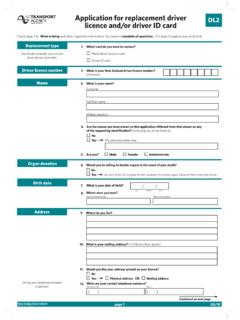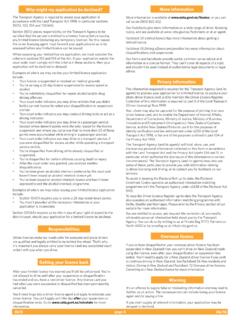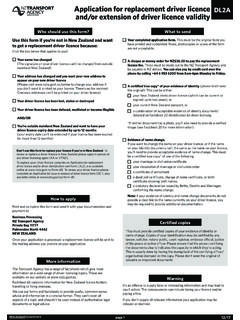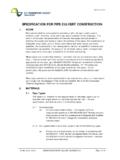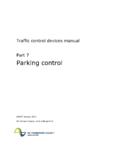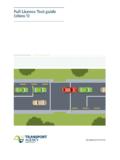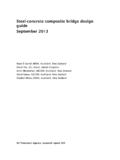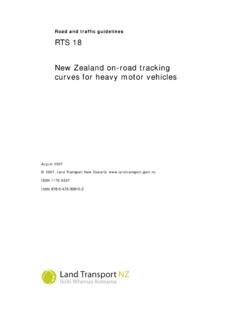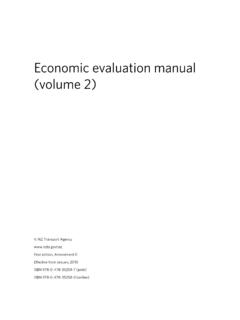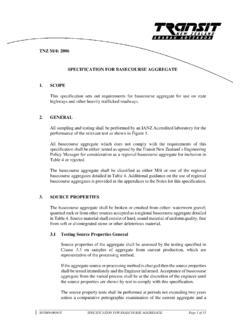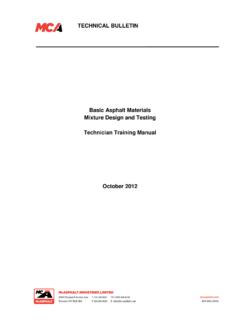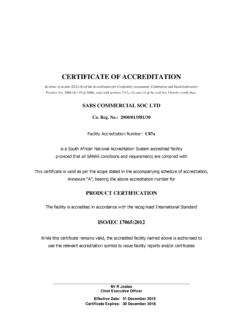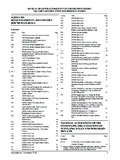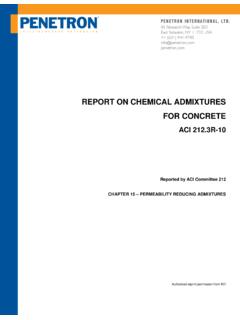Transcription of Specification for first coat sealing TNZ P/3
1 SP/SP3:89 XXXX Specification FOR first coat sealing Page 1 of 14 TNZ P/3: 1995 Specification FOR first coat sealing 1. SCOPE The first coat seal shall be applied in accordance with this Specification upon the finished surface of compacted granular basecourse pavement. 2. EDGE DEFINITION AND TOLERANCE The edges of the sealing course shall be clearly defined by string lines. Ragged or irregular edges to the sealing will not be permitted. No peg or spike shall be left as a danger to traffic. The width of the seal coat shall not be less than the width defined in the job Specification and no payment will be made for any excess width greater than 100 mm. 3. sealing PERIOD sealing in accordance with this Specification may be carried out during any period of the year when fair settled weather conditions are being experienced, provided that the shade air temperature within the area being sealed is not less that 10 C.
2 4. WORKING HOURS The Contractor shall not work on the site on Public Holidays except for the work described in Clauses 26, 27 and 28, unless with the specific approval of the Engineer. All binder spraying shall be completed at least 90 minutes before the official time of sunset and all plant shall be clear of the sealed area by sunset, except with the specific approval of the Engineer. 5. USE OF PRIVATE LAND Additional to the provisions of Clause of the General Conditions of Contract, the Contractor should make his own arrangements in respect of any use of private land outside the limits of the contract works and he shall be responsible for any damage or claims for compensation arising from such use. Before the expiry of the maintenance period, as defined in the Special Conditions of Contract, the Contractor shall submit letters form any landowners concerned certifying that all claims for compensation due to TNZ P/3: 1995 SP/SP3:89 XXXX Specification FOR first coat sealing Page 2 of 14 the use of the land by the Contractor have been discharged to the satisfaction of the landowners.
3 6. CONSTRUCTION PLANT All plant items shall be in good mechanical condition and in particular no fault that could present a hazard shall be permitted. Oil, water or fuel leaks will render a plant item unacceptable. Chip spreading equipment shall be capable of spreading the aggregate evenly, at a controlled rate, over a width of at least m and shall be fitted with a positive means of adjusting the width of spread. Control of spread width shall be adjustable only from the side of the spreader. The design of the spreading equipment and the operating speed of the spreading vehicle shall ensure that the sealing chip is dropped in such a way that it does not tumble on impact with the sprayed surface. The rollers shall be self propelled and have a minimum weight when operating of not less than seven tonnes, spread over at least seven smooth pneumatic tyred, wheels.
4 Any roller exceeding 13 tonnes shall be deemed, for the purpose of this Specification , to weight 13 tonnes. The tyres shall be inflated to not less than 600 kPa and adequate means of checking tyre pressures on site shall be provided by the Contractor. An approved steel wheeled roller as specified in Clause 22 may be acceptable for not more than the first two passes required for the initial rolling. All rollers to be used shall be weighed at the Contractor's expense in the presence of the Engineer or his representative before the work within the contract is commenced. The ballast quantity on each roller at the time of the weighing will be recorded together with registration and plant numbers. Specific models of rubber-coated vibrating drum rollers may be approved, with specified limits and conditions, by the General Manager of Transit New Zealand to be used to obtain the rolling as specified in Clause 22 to be equivalent to pneumatic tyred rollers as specified above.
5 Contractors shall produce written evidence of the approval for use of any rubber-coated vibrating drum roller. Such approved rollers in service or proven to be on form order prior to 1 November 1984 only shall be accepted to obtain the total rolling specified in Clause 22. Bitumen distributors shall possess a current Certificate of Compliance with the BCA E/2 Specification for Performance of Bitumen Distributors administered by the New Zealand Bitumen Contractors' Association Inc. There shall be an operator carried at the rear of the distributor to operate the functions designated in Clauses and of that Specification , unless otherwise approved in writing by the Engineer. TNZ P/3: 1995 SP/SP3:89 XXXX Specification FOR first coat sealing Page 3 of 14 7. CONDITION OF SURFACE FOR sealing Where the construction of the basecourse is not part of the contract, the Engineer will define the dates of handing over the lengths of road to be sealed after considering the Contractor's proposed timing and sequence of operations.
6 The road will be handed over to the Contractor in good condition, with not less than two consecutive working days ahead, ready to be prepared for sealing unless otherwise stated in the job Specification . From the date of handing over, any work necessary to retain or reinstate the surface shall be at the Contractor's expense. Any loose or caked material on the surface shall be removed and disposed of without disturbing the compacted basecourse. The surface shall then be swept clean of loose aggregate, dust, dirt and other deleterious matter and the sweepings shall be removed to the satisfaction of the Engineer. The surface of the road at the time of sealing shall be clean, reasonably dry and free of ice or frost, tightly compacted and shall present a clean stone mosaic appearance. 8. ASPHALT CEMENT The asphalt cement shall be 180/200 penetration grade and shall meet the requirements defined for that grade in TNZ M/1, Specification for Asphaltic Bitumens.
7 9. ADHESION AGENT An adhesion agent approved and blended in accordance with the requirements of TNZ M/13 Specification for Adhesion Agents shall be incorporated in the sealing binder. Effect on Viscosity Adhesion agents have a viscosity reducing effect on bitumen equal to that of kerosene and automotive gas oil (AGO). This is taken into account when determining the total amount of diluent required in Table 1. 10. FLUXING The asphalt cement shall be blended with the quantity of automotive gas oil as specified elsewhere in the Contract Documents. The automotive gas oil shall comply with the requirements for that material as specified in TNZ M/1, Specification for Asphaltic Bitumens. TNZ P/3: 1995 SP/SP3:89 XXXX Specification FOR first coat sealing Page 4 of 14 11. CUTTING BACK The asphalt cement shall be cut back with lighting kerosene so that the total diluent content of the binder is in accordance with Table 1.
8 Binder which is sprayed while the shade air temperature of the site is rising shall be blended in accordance with the maximum expected temperature on the day. The maximum temperature shall be estimated by the Contractor and approved by the Engineer. Binder sprayed while the shade air temperature is falling shall be blended in accordance with the shade air temperature measured at the time of spraying. Interpolation may be used to obtain intermediate values from Table 1. The formulations may be used over a range of 3oC from the specified temperatures, except that where only six parts of total diluents are required, the upper temperature limit shall not apply. Binder not complying with this clause shall not be used without reblending. The lighting kerosene shall comply with the requirements defined for this material in TNZ M/1, Specification for Asphaltic Bitumens.
9 Table 1 Shade Air Temperature oC Total Diluents, Automotive Gas Oil, Lighting Kerosene and Adhesion Agents Parts Per Hundred Parts of Asphaltic Cement (Measured by Volume at 15o C) and over 15 14 13 11 9 7 6 Alternatively, a proprietary first coat sealing binder may be specifically directed or approved by the Engineer. 12. BLENDING THE sealing BINDER The total quantity of each component incorporated into the sealing binder shall be accurately measured by a volume metering or weighing device certified by the Weights and Measures Division of the Ministry of Commerce. The binder shall be thoroughly mixed before use. All plant and methods used to blend the binder shall be approved by the Engineer. TNZ P/3: 1995 SP/SP3:89 XXXX Specification FOR first coat sealing Page 5 of 14 The Engineer may, by specific direction in the contract or job Specification require that cutback, adhesion agent and/or flux is to be blended either at a central blending plant or on site.
10 When blending is done in a central blending plant, or in the absence of the Engineer or his representative, the Contractor shall provide a blending certificate with each load of binder. The certificate shall list the following: (a) Time and date of blending; (b) Temperature of asphalt cement when blended; (c) Grade of asphalt cement; (d) Number of parts of automotive gas oil per 100 parts of asphalt cement; (e) Number of parts of kerosene per 100 parts of asphalt cement; (f) Type and quantity of adhesion agent (in parts per 100 parts of asphalt cement as well as the quantity in either kilograms or litres at 15oC). If the Contractor fails to provide the specified blend or to provide accurate delivery certificates, the Engineer will require the Contractor to blend only in the presence of the Engineer or his representative, at times and locations previously approved by the Engineer.
